#marquise casati stampa
Text
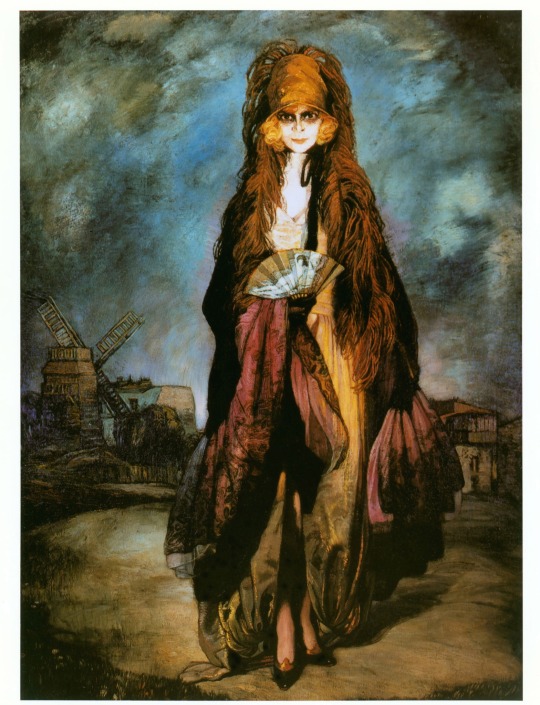
Marchesa Luisa Casati, 1923. Found in the collection of Espacio Cultural Ignacio Zuloaga (Ignacio Zuloaga y Zabaleta (Spanish, 1870-1945),
#marchesa luisa casati#painting#1923#art#marchesa casati#la casati#la marchesa#luisa casati#luisa marchesa casati stampa di soncino#marquise de casati#marquise casati stampa di soncino#marquise casati#marchesa#marchesa luisa#marquise luisa casati#marquise casati stampa#luisa casati stampa#casati stampa#marchesa luisa casati stampa#Ignacio Zuloaga y Zabaleta#Ignacio Zuloaga#Zuloaga
30 notes
·
View notes
Video
(via Mysteries Of Venice - The Lady Of Burano - The Divine Marq… | Flickr)
Mysteries Of Venice - The Lady Of Burano - The Divine Marquise by Daniel Arrhakis (2023)
With the music : Dark Autumn Music - Autumn Chills / Brandon Fletcher
youtu.be/Rb7SPCryTZM?list=PLvt6HApChohD2bqzTmx3zmdxTkIIlUtY6
The Lady Of Burano - The Divine Marquise (*)
Luisa Amman was born in Milan in 1881 into a very rich family, as her father was a cotton producer. She soon showed a strong and eccentric personality and became passionate about the lives of great people, such as the Empress of Austria Sissi.
Her androgynous appearance, her slender and thin physique, her penetrating and cheeky gaze always attracted the attention of those around her. Little more than an adult, she chose to marry the Marquis Camillo Casati Stampa di Soncino, becoming the Marquise Luisa Casati Stampa. But she discovered very soon that the role of a quiet life of wife and mother did not agree with her free and rebellious soul to the stereotypes of the time.
Only after 10 years of marriage she choose to leave Milan to move to Venice and live her eccentric and nonconformist spirit of life.
She bought the Palazzo Venier of Lions on the Grand Canal and in the villa she held sumptuous parties and dances that attracted prominent personalities from all corners of the world, and populated the garden with exotic animals, such as albino blackbirds, leopard cats, parrots, boas and a cheetah.
One of her most singular habits was to walk in St. Mark's Square in the evening, naked, covered only with a fur coat holding her cheetah on a leash, while a faithful servant would follow her with a torch so that she would be illuminated in the darkness of the night and admired by passers-by.
The frequentation of literary circles allowed her to meet Gabriele D'Annunzio with whom she lived a long history of clandestine love, as she was still married to the Marquis.
But there was another love that remained secret until today, which made her go to the island of Burano on certain nights of the new moon, hidden behind a porcelain mask and ivory silk robes. On the island they called her the "Lady In White And Copper" or the "Mysterious Lady of Burano".
The unbridled luxury of Casati did not last forever and in the last years of her life she left Venice for London, where she died in total misery in 1957, taking their best kept secret with her.
(*) History (largely based on true facts) and Image by Daniel Arrhakis.
0 notes
Photo

Marchesa Luisa Casati
Portrait by Federico Beltrán Masses, 1920.
#Marchesa Luisa Casati#Federico Beltrán Masses#1920#Luisa Casati#Federico Armando Beltrán Masses#Beltrán Masses#Luisa Marchesa Casati Stampa di Soncino#la casati#marchesa casati#la marchesa casati#marquise luisa casati#marchesa#muse#fashionista
259 notes
·
View notes
Photo

🔸 Luisa, Marquise Casati Stampa di Soncino (23 January 1881 – 1 June 1957) was an eccentric Italian heiress, muse, and patroness of the arts in early 20th-century Europe. As the concept of dandy was expanded to include women, the marchesa Casati fitted the utmost female example by saying: "I want to be a living work of art". Photographed c.1899. #victorianchaps #vintage #1890s #portrait #beauty #goodolddays #oldphoto #victorian #pastlives #italy🇮🇹 #nostalgia #eccentric #dandy #history #retro https://www.instagram.com/p/CTMWFDGgLmz/?utm_medium=tumblr
#victorianchaps#vintage#1890s#portrait#beauty#goodolddays#oldphoto#victorian#pastlives#italy🇮🇹#nostalgia#eccentric#dandy#history#retro
66 notes
·
View notes
Photo

Marquise Luisa Casati by Baron Adolph de Meyer 1912
Luisa Casati Stampa di Soncino, Marchesa di Roma (Milan, 23 January 1881 - London, 1 June 1957) was an eccentric Italian heiress, muse, and patroness of the arts in early 20th century Europe.
#marquise#Luisa Casati#1912#10s#eccentric#italian#heiress#muse#patroness of the arts#photography#Baron Adolph de Meyer#portrait
4 notes
·
View notes
Text
“Quite suddenly and simply by chance, I once met a bizarre lady while taking tea with some friends in London. She arrived wearing black velvet from head to foot, her mouth painted blood red, and carrying a very tall umbrella with a decorated handle. And, you must understand, this ensemble was being worn in the middle of the day. This picturesque ruin of a woman was very tall and thin, and gave the impression of formidable strength. It was then I was introduced to the Marchesa Luisa Casati for the first and last time. She had made her entrance into that room looking wonderful and saying very little. She wasn’t beautiful-she was spectacular. Here was a woman possessing a presence one would never forget.”
- Quentin Crisp
#quote#quentin crisp#quentin crisp quote#marchesa luisa casati#luisa casati#la marchesa#luisa marchesa casati stampa di soncino#marchesa casati#marquise casati#marquise casati stampa di soncino#marchesa#marchesa casati stampa#luisa amman#luisa amman casati#luisa casati stampa#stampa#marquise casati stampa#la marquise casati stampa#luisa marchesa casati stampa#luisa marquise casati stampa#marquise de casati#marquise#caracter quote#strenght
10 notes
·
View notes
Photo
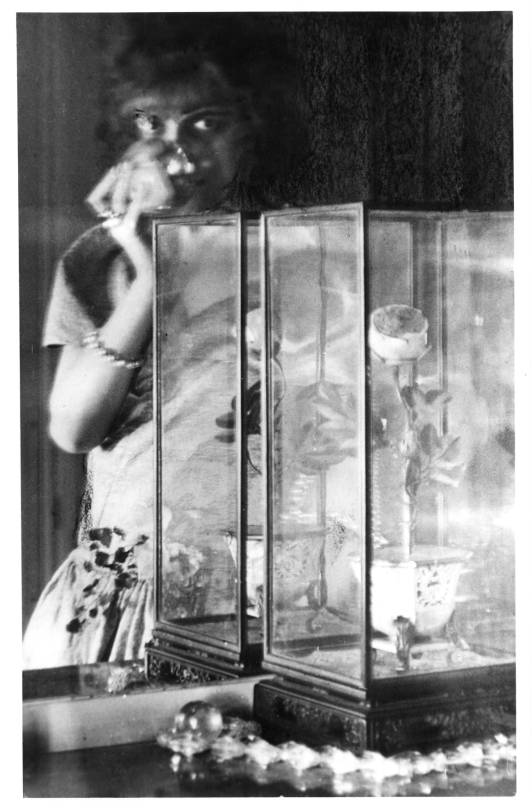
1922 Man Ray, Marchesa Luisa Casati.
"In 1922, Luisa visited a young and still unknown photographer named Man Ray. In his autobiography, the American tells the story of the photo that became the most famous of all the representations of the Marchioness Casati (...) "I drew a few where one could distinguish a semblance of face; On one of the negatives, we saw three pairs of eyes. It could have been mistaken for a surreal version of the Medusa. It was precisely this photo that delighted her: I had made a portrait of her soul, she said, and she ordered dozens of copies from me. I wish my other clients had been so easy to please. The photo of the marquise went around Paris. Figures from the most closed circles began to come, all expecting miracles. I had to leave my hotel room and find a real studio. » (x)
#1922#portrait#man ray#marchesa luisa casati#luisa casati#marchesa casati#marquise casati#Marquise luisa casati#la Marquise#luisa amman casati#Luisa Adele Rosa Maria von Amman#Luisa Adele Rosa Maria Amman#Luisa Amman#Marquise Casati Stampa di Soncino#Marchesa Casati Stampa di Soncino#Luisa Marchesa Casati Stampa Di Soncino#Luisa Casati Stampa di Soncino#Marchesa Casati Stampa
153 notes
·
View notes
Photo
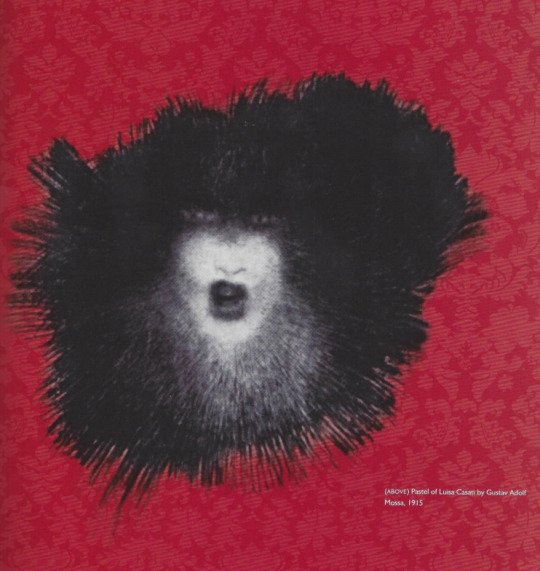
Gustav Adolf Mossa, Pastel of Marchesa Luisa Casati. 1915
Luisa was on holiday in Nice when she chanced accorss the work of Gustav Adolf Mossa. This French symbolist dedicated his craft to rendering fantastical creatures of myth – many of them in ghoulish feminine forms with bloodied lips and nightmarish eyes. His unsettling pastel vision of Luisa reduces her to a shrieking, nonhuman elemental force. At least in part, Mossa perhaps meant the almost perceptible scream from his siren-like subject to echo the horror and indignation expressed by so many at the recent start of the First World War. (x)
#gustav adolf mossa#pastel#painting#1915#art#marchesa luisa casati#la casati#mossa#la marchesa#luisa casati#marquise casati#marchesa#marquise#marchesa casati#Marchesa Luisa Casati.#Marchesa Casati Stampa#casati#stampa#Marquise Casati Stampa di Soncino#Marchesa Casati Stampa di Soncino#Luisa Marchesa Casati Stampa Di Soncino#Luisa Casati Stampa di Soncino#luisa amman casati#Luisa Adele Rosa Maria von Amman#Luisa Adele Rosa Maria Amman#amman#Luisa Amman#Marquise luisa casati#la Marquise
124 notes
·
View notes
Photo
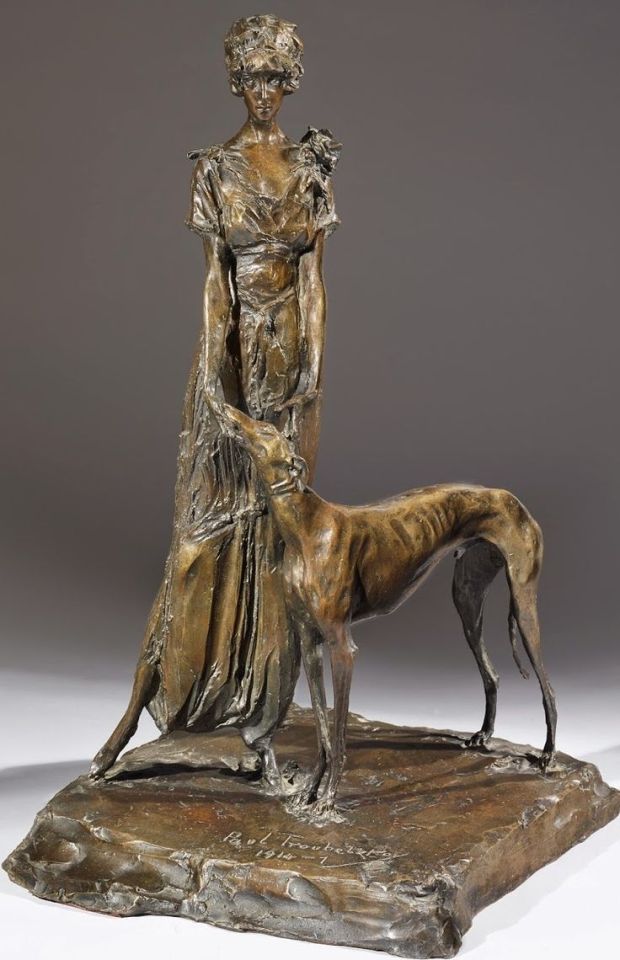
Prince Paolo Petrovich Troubetzkoy (Italian 1866-1938), Bronze Sculpture Marchesa Luisa Casati with Greyhound, 1914.
Prince Paolo Petrovich Troubetzkoy was an artist and a sculptor who was described by George Bernard Shaw as "the most astonishing sculptor of modern times".
#paolo troubetzkoy#sculpture#1914#bronze sculpture#marchesa luisa casati#greyhound#marchesa#luisa casati stampa#luisa casati#luisa amman#marquise casati#Marquise luisa casati#marchesa casati#Marchesa Casati Stampa#socialite#Prince Paolo Petrovich Troubetzkoy#sculptor#italian sculptor#astonishing sculptor#george bernard shaw#muse#icon#italian socialite#socialites
101 notes
·
View notes
Photo
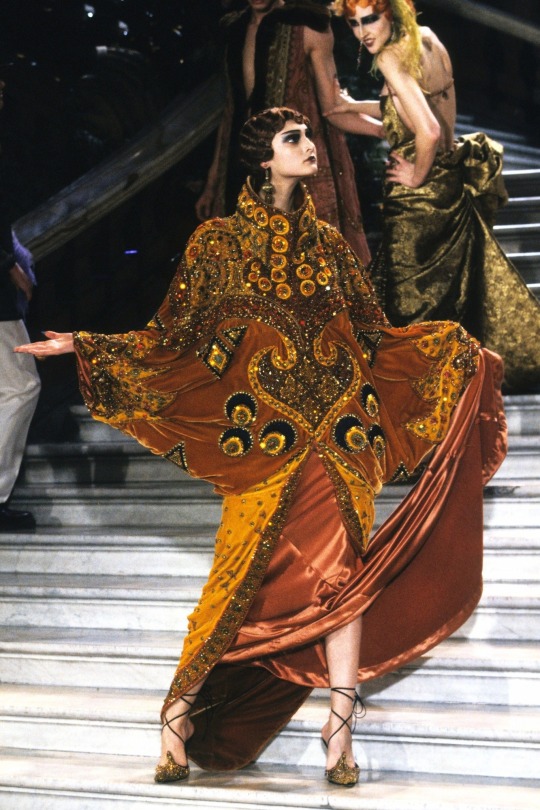
John Galliano for Christian Dior, Haute Couture, Spring Summer Collection, 1998.
Tribute to Marchesa Luisa Casati.
Not long after his arrival at Christian Dior, John Galliano invited us all to Paris’s Opera Garnier, where he staged what was probably his most lavish spectacle ever for the house on its grand marble steps. With the Marchesa Luisa Casati for a muse, the clothes looked straight out of an early 20th-century salon or ball. There were backless velvet gowns in Art Nouveau prints, opera coats with deep mink trim, lace sheaths and skirtsuits, and rose-strewn picture hats. And for the finale? A shower of pastel-colored tissue-paper confetti cut into the shape of tiny butterflies. Pure magic. (x)
#1998#haute couture#john galliano#christian dior#marchesa luisa casati#galliano#dior#opera garnier#art nouveau#luisa casati#luisa amman casati#luisa amman#opera garnier paris#paris#marchesa casati#Luisa Casati Stampa di Soncino#Marchesa Luisa Casati.#marquise casati#Marchesa Casati Stampa#muse#20th century fashion#salon#ball#velvet gowns#backless gowns#gowns#tribute#homage#homage to marchesa luisa casati
106 notes
·
View notes
Photo

1922 Man Ray, Marchesa Luisa Casati.
"In 1922, Luisa visited a young and still unknown photographer named Man Ray. In his autobiography, the American tells the story of the photo that became the most famous of all the representations of the Marchioness Casati (...) "I drew a few where one could distinguish a semblance of face; On one of the negatives, we saw three pairs of eyes. It could have been mistaken for a surreal version of the Medusa. It was precisely this photo that delighted her: I had made a portrait of her soul, she said, and she ordered dozens of copies from me. I wish my other clients had been so easy to please. The photo of the marquise went around Paris. Figures from the most closed circles began to come, all expecting miracles. I had to leave my hotel room and find a real studio. » (x)
#1922#portrait#photography#man ray#marchesa luisa casati#luisa casati#la casati#la marquesa#marquise casati#casati#marchesa casati#Marchesa Casati Stampa#luisa amman casati#Luisa Adele Rosa Maria von Amman#Luisa Amman#Luisa Adele Rosa Maria Amman#amman#Marquise Casati Stampa di Soncino#Marchesa Casati Stampa di Soncino#Luisa Marchesa Casati Stampa Di Soncino#Luisa Casati Stampa di Soncino#la Marquise#Marquise luisa casati#marquise#medusa#soul#emmanuel radnitzky#master photographer
65 notes
·
View notes
Photo
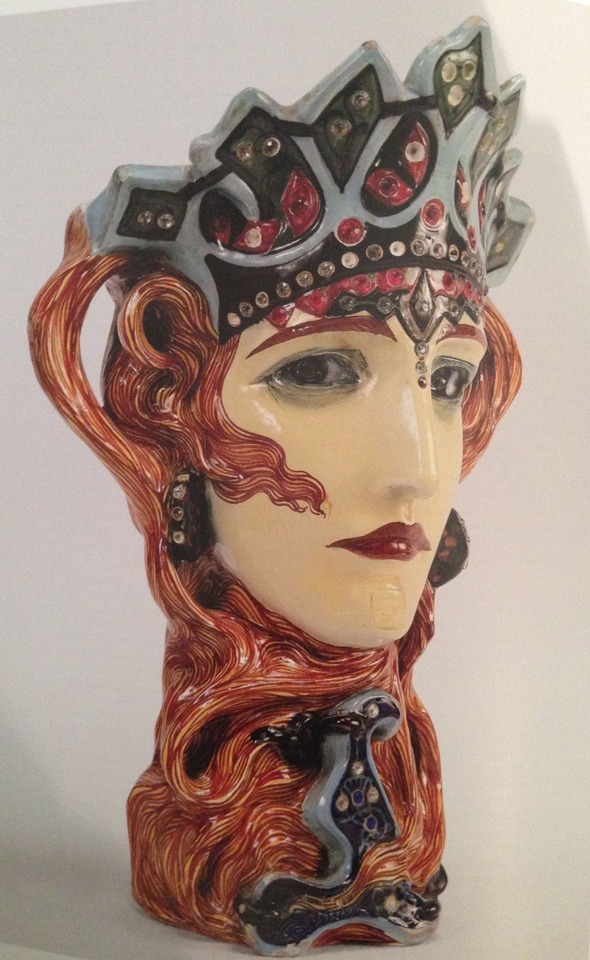
1920 Renato Bertelli, Marchesa Luisa Casati in Medusa Mask, Ceramic glazed ceramic with brilliant cut glass applications, h 37 cm, Ceramic Factory Salvini Ro, Ferrara, Cavallini Foundation.
#1920#mask#ceramic mask#medusa mask#renato bertelli#marchesa casati#luisa casati#marchesa luisa casati#la casati#la marchesa#la marquise#luisa amman#marquise casati#Marchesa Casati Stampa#Marquise Casati Stampa di Soncino#Marchesa Casati Stampa di Soncino#Luisa Marchesa Casati Stampa Di Soncino#Luisa Casati Stampa di Soncino#luisa amman casati#Luisa Adele Rosa Maria von Amman#Luisa Adele Rosa Maria Amman#Marquise luisa casati#marquise
34 notes
·
View notes
Photo

1920 Romaine Brooks, Marchesa Luisa Casati.
"Between Luisa and Romaine Brooks, it started as a game. True to her habits, Luisa had sought to surround herself with all that the island could count of marginals and artists (...) Luisa, who had an unfortunate tendency to think that money could buy everything, ordered a painting. His portrait. Romaine refused. (...) Romaine, running out of argument, claimed that she painted only nudes. Never mind, Luisa would take off her clothes. (...) It was Roman who succumbed. Luisa didn't see him. Luisa wanted to seduce Romaine, while Romaine already loved her. Initially, she acts awkwardly. Sometimes nervous, sometimes stultified by spending whole afternoons on Adelswärd-Fersen's couch in a state halfway between orgasm and coma. A latent and unfulfilled desire made her irascible. Was she excited about the idea of having a lesbian experience? Romaine had refused to paint it. Perhaps more than anything, this is what sparked his desire. » (x)
#1920#romaine brooks#marchesa luisa casati#casati#luisa casati#marchesa#marquise#marchesa casati#marquise casati#Marchesa Casati Stampa#Luisa Amman#Luisa Adele Rosa Maria Amman#Luisa Adele Rosa Maria von Amman#luisa amman casati#Luisa Casati Stampa di Soncino#stampa#Luisa Marchesa Casati Stampa Di Soncino#Marquise Casati Stampa di Soncino#Marchesa Casati Stampa di Soncino#la marquise#la marchesa
46 notes
·
View notes
Photo

1935 Man Ray (1890-1976), Marchesa Luisa Casati dressed as Empress Elisabeth of Austria (Sissi), with “Flick” and “Flock” as a back-ground, at the Beaumont Ball.
She was a force of nature and made her mark on everyone she met, exerting a magnetism on her contemporaries. The marquise used the public realm as a theatre scene of a play where she was very much the star. Her every public appearance was a true show, since she wanted to be, as she said “a living work of art”.
Sotheby’s
#1935#photography#man ray#muse#subject#luisa casasti#marchesa lusa casati#marquise casati#force of nature#marchesa casati#marchesa luisa casati#luisa casati#casati#Luisa Casati Stampa di Soncino#Luisa Marchesa Casati Stampa Di Soncino#Marchesa Casati Stampa di Soncino#Marquise Casati Stampa di Soncino#La Marquise Casati#la marquesa luisa casati#La Marquise de Casati#la marquis#la marchesa#la marquise casati stampa#siss#sisi#elisabeth of austria#stars#flick#flock#Beaumont Ball
38 notes
·
View notes
Photo

Giovanni Boldini, La Marchesa Luisa Casati con penne di pavone (Portrait of the Marquise). 1911-1913
Galleria Nazionale d'Arte Moderna e Contemporanea.
"The Marquise Casati had diamond shoes, dyed her hair green, frequented the greatest artists, took every drug possible, organized spectacular balls, loved a boa constrictor, made headlines and lived at the Ritz... An original Italian of the early twentieth century, Luisa Casati squandered her fortune on villas and munificent castles (such as the Palais Rose at Le Vésinet near Paris), eccentric outfits, and portraits. Becoming the woman most represented by the artists of her time: from Van Dongen to Man Ray via Picasso who designed her a ball gown... Dead ruined, she remains a style icon with her iconic red mane inspiring Sonia Rykiel, the Chanel Cruise 2010 or Dior 1998 collections... The young novelist Camille de Peretti is now following in the footsteps of this eccentric and patron of the arts. Comparing in a funny mise en abime the life of the expensive marquise friend of artists and her own experience as a painter's ex-wife without the money. Through seven of his portraits, Camille de Peretti recounts the encounter between the Casati and the artists of his time. (x)
#Giovanni Boldini#painting#portrait#1911#marchesa luisa casati#boldini#la marcehsa casati#la marchesa luisa casati#luisa casati#luisa amman#Luisa Casati Stampa di Soncino#marquise casati#marquise#marchesa#marchesa casati#Marchesa Casati Stampa#Marchesa Luisa Casati.#the marquise#Marquise luisa casati#art
42 notes
·
View notes
Photo

John Galliano for Christian Dior, Haute Couture, Spring Summer Collection, 1998.
Models: Eva Herzigova, Eugenia Silva, Debra Shaw, Phoebe O'Brien, Astrid Muñoz, Jade Parfitt & Suzanne Von Aichinger.
Tribute to Marchesa Luisa Casati.
Opera Garnier, Paris.
#1998#haute couture#john galliano#christian dior#galliano for dior#ss#tribute#homage#Marchesa#marchesa luisa casati#luisa casati#luisa amman#Marchesa Casati Stampa#marchesa casati#marquise casati#casati#opera garnier#opera garnier paris#galliano#dior#genious#fashion love
36 notes
·
View notes